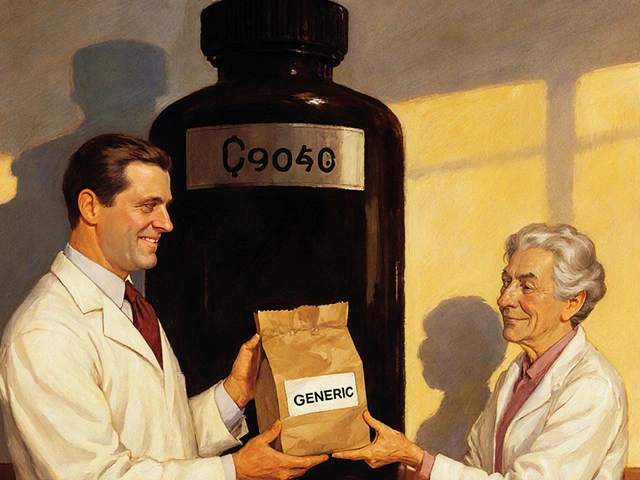People hear that fenofibrate lowers triglycerides and wonder: does it actually protect my heart in the long run? The honest answer is nuanced. Fenofibrate can reduce cardiovascular events for the right person, but it’s not a magic bullet for everyone. Expect best results if you’ve got high triglycerides and low HDL-especially with type 2 diabetes-and you’re already on a statin. You’ll also see unique eye benefits if you have diabetes. This guide lays out what the research really shows, how to use fenofibrate safely for years, and whether it fits your situation.
TL;DR
- Fenofibrate lowers triglycerides 30-50% and nudges HDL up. It hasn’t shown broad mortality benefits, but it reduces heart events in people with high triglycerides and low HDL (often those with type 2 diabetes).
- Pair with a statin if your LDL is controlled but triglycerides stay high. Avoid as a replacement for statins in atherosclerotic disease.
- Unique long-term bonus: slower diabetic retinopathy progression and fewer laser treatments in trials.
- Safety over years is generally good: expect a small, reversible bump in creatinine, and monitor liver enzymes, kidney function, and muscle symptoms.
- Best fit: triglycerides ≥2.3 mmol/L (≥200 mg/dL) with low HDL, especially in type 2 diabetes. Not ideal if you have significant kidney or liver disease, active gallbladder disease, or during pregnancy.
What the Long-Term Evidence Actually Shows
Fenofibrate’s long game is about reducing triglyceride-rich lipoproteins (like VLDL and remnants), modestly improving HDL, and tweaking LDL particle size. Over time, this can translate into fewer cardiovascular events-but not for everyone. The pattern of your lipids matters more than any single number.
Two cornerstone trials dominate the conversation. The FIELD trial (Lancet, 2005) followed over 9,000 people with type 2 diabetes for five years. Fenofibrate didn’t significantly cut the primary composite of coronary events for the whole group, but it did reduce nonfatal myocardial infarction and need for revascularization, and it lowered the need for laser therapy in diabetic retinopathy. ACCORD-Lipid (NEJM, 2010) tested fenofibrate added to statin therapy in more than 5,000 people with type 2 diabetes. Overall, no significant reduction in the primary endpoint-until you zoom in on the subgroup with high triglycerides and low HDL, where the combination cut events by about a third. That subgroup story keeps showing up in pooled analyses.
Meta-analyses confirm the theme. Across fibrate trials (fenofibrate included), you see a drop in nonfatal MI and composite cardiovascular events, but no consistent mortality benefit. The gains are concentrated in those with triglycerides above roughly 2.3 mmol/L (200 mg/dL) and HDL below about 1.0 mmol/L (40 mg/dL in men, 1.3 mmol/L in women). Think of fenofibrate as a precision tool for an atherogenic dyslipidaemia pattern-especially in diabetes.
There’s also the eye angle. Both ACCORD Eye (Lancet, 2010) and FIELD substudies reported slower progression of diabetic retinopathy and fewer laser treatments in patients on fenofibrate. That’s rare in lipid drugs and clinically meaningful for people with established retinopathy. In some countries this has influenced practice; in the UK, fenofibrate is not licensed for retinopathy, but that evidence can tip the scales when choosing add-on therapy in a person with diabetes and high triglycerides.
What about pancreatitis? Severe hypertriglyceridaemia raises pancreatitis risk. By lowering triglycerides, fenofibrate is used to reduce that risk long-term, particularly when fasting triglycerides run above ~5.6 mmol/L (500 mg/dL), and especially above 10 mmol/L (885 mg/dL). Trial data on pancreatitis events are limited, but the biological logic and clinical experience align here.
Mortality is the sticking point. Across decades, fibrates haven’t robustly moved all-cause mortality. That doesn’t negate their value; it just means they should be targeted. If your LDL is high or you’ve had a heart attack or stroke, a statin remains the backbone. Fenofibrate is an add-on for the right profile, not a statin substitute.
| Study | Population | Follow-up | Main Long-Term Results | Who Benefited Most |
|---|---|---|---|---|
| FIELD (Lancet, 2005) | 9,795 with type 2 diabetes; many not on statins at start | 5 years | No significant reduction in primary coronary events overall; fewer nonfatal MI and revascularizations; fewer laser treatments for retinopathy | Patients with higher TG and lower HDL |
| ACCORD-Lipid (NEJM, 2010) | 5,518 with type 2 diabetes; fenofibrate + simvastatin vs simvastatin | 4.7 years | No overall reduction in primary composite; subgroup with high TG (≥2.3 mmol/L) and low HDL saw ~31% event reduction | High TG + low HDL subgroup |
| ACCORD Eye (Lancet, 2010) | Substudy of ACCORD participants with retinal exams | 4 years | Lower progression of diabetic retinopathy with fenofibrate | People with existing diabetic retinopathy |
| FIELD Eye Substudies | Type 2 diabetes, ophthalmic follow-up | 3-5 years | Reduced need for laser therapy and slower retinopathy progression | Those with baseline retinopathy |
One more wrinkle: newer selective PPAR-α agonists like pemafibrate looked promising for triglycerides but didn’t reduce cardiovascular events in a large 2022 trial. That doesn’t erase fenofibrate’s subgroup benefits; it does remind us that lowering triglycerides isn’t enough by itself-you need the right patient profile.
Who Should Consider Fenofibrate-and Who Shouldn’t
Fenofibrate is not a blanket solution. It shines when triglycerides are high despite good LDL control, usually on a statin. Here’s a practical way to frame the decision.
- Good candidates
- Type 2 diabetes with persistent triglycerides ≥2.3 mmol/L (≥200 mg/dL) and low HDL despite lifestyle and statin. Evidence suggests fewer cardiovascular events over time.
- Mixed dyslipidaemia (high TG, low HDL) with features of metabolic syndrome even without diabetes, after LDL is sorted.
- Severe hypertriglyceridaemia (≥5.6 mmol/L / ≥500 mg/dL), particularly if approaching ≥10 mmol/L (≥885 mg/dL), to lower pancreatitis risk.
- Statin-intolerant patients who need triglyceride lowering; fenofibrate won’t deliver statin-level LDL reductions, but it can tackle triglycerides and remnants.
- Use with caution or avoid
- Significant renal impairment: dose reduction if eGFR 30-59 mL/min/1.73 m²; avoid if eGFR <30. Fenofibrate can raise creatinine; this is typically reversible but needs watching.
- Liver disease: avoid in active hepatic disease or persistent unexplained transaminase elevations.
- Gallbladder disease: fenofibrate can increase gallstone risk. Avoid if you’ve got active gallbladder disease.
- Pregnancy and breastfeeding: not recommended.
- Drug interactions: combines more safely with statins than gemfibrozil does, but still watch for muscle symptoms. Warfarin effect can be potentiated-INR monitoring is essential.
UK angle (2025): NICE recommends statins first-line for cardiovascular risk reduction. Consider fenofibrate primarily for severe hypertriglyceridaemia (to prevent pancreatitis) or as add-on when triglycerides remain high despite statins and lifestyle. That dovetails with what the big trials showed.
How about HDL? Fenofibrate raises HDL modestly, but targeting HDL per se is yesterday’s game. What matters is the atherogenic remnant burden and your overall risk. If you’ve got ASCVD or very high risk, keep the statin on board. If triglycerides stay elevated, fenofibrate becomes relevant.
Real example: a 58-year-old with type 2 diabetes on high-intensity statin shows LDL 1.6 mmol/L (62 mg/dL), triglycerides 3.2 mmol/L (283 mg/dL), HDL 0.9 mmol/L (35 mg/dL). This is the exact profile where fenofibrate as add-on can lower the odds of nonfatal events over the next few years and may also slow eye disease.

Using Fenofibrate Safely for Years: Dosing, Labs, and Watchouts
Long-term safety with fenofibrate is generally good when you dose wisely and keep an eye on labs. The common pattern is a small bump in serum creatinine within weeks; trials show it tends to stabilize and reverses when you stop the drug. That bump seems to reflect altered creatinine handling more than kidney damage, but you still monitor kidney function routinely.
Typical dosing: 145 mg once daily (nanocrystallised tablet) or 160 mg depending on brand. Take with food if the product label advises-absorption can vary by formulation. For eGFR 30-59, many UK products advise 48-67 mg daily; check the exact brand’s SmPC. Avoid if eGFR <30.
What to check and when
- Baseline: lipid panel, ALT/AST, eGFR/creatinine, CK if muscle symptoms or high risk, HbA1c if you have diabetes, and a medicines review (statins, warfarin, ciclosporin).
- 4-12 weeks after starting or changing dose: repeat lipid panel and eGFR/creatinine; ALT/AST; CK if symptomatic.
- Ongoing: every 6-12 months if stable; sooner if the dose changes, kidney function dips, or symptoms appear.
Thresholds that trigger action
- ALT/AST persistently >3× upper limit of normal: stop and reassess.
- Creatinine rises substantially from baseline or eGFR falls <30: reduce dose or stop; recheck after dechallenge.
- Muscle pain with CK >5× upper limit or rhabdomyolysis signs: stop immediately; manage urgently.
- New gallbladder symptoms (upper right abdominal pain, fever, jaundice): evaluate for gallstones.
Side effects to keep on your radar
- Common: digestive upset, mild increases in liver enzymes, reversible creatinine rise.
- Less common but important: myopathy (especially with statin combination), gallstones, photosensitivity rash.
How it plays with statins
- Fenofibrate + statin is the usual combo if your LDL is controlled but triglycerides aren’t. The myopathy risk is lower than with gemfibrozil + statin, but it’s not zero. Start low, go steady, and educate about muscle symptoms.
- Simvastatin carries higher myopathy risk than some others; in practice many clinicians pair fenofibrate with atorvastatin or rosuvastatin when needed.
Lifestyle still matters
- Diet: cut refined carbs and alcohol-both spike triglycerides. Prioritise fibre, lean protein, and healthy fats; consider a Mediterranean-style pattern. Even 5-10% weight loss can drop triglycerides meaningfully.
- Activity: regular movement improves triglyceride clearance-aim for 150 minutes per week of moderate activity plus two strength sessions.
- Diabetes control: high glucose fuels high triglycerides. Tighter glycaemia often trims triglycerides without extra pills.
Simple checklist you can screenshot
- Do I have the target profile (high TG, low HDL, LDL already managed)?
- Have I ruled out secondary causes (alcohol, hypothyroidism, steroids, uncontrolled diabetes)?
- Baseline labs done (lipids, liver, kidney, CK if needed)?
- Follow-up labs booked in 8-12 weeks?
- Statin on board if indicated? Any interaction risks (warfarin, ciclosporin)?
- Plans for sun protection and a nudge to report muscle pain or abdominal pain quickly?
Scenarios, FAQs, and Your Next Steps
Here are the situations I see most often, plus what to do next.
Scenario: My LDL is fine on a statin, but my triglycerides are still 2.8 mmol/L (250 mg/dL). Worth adding fenofibrate?
Likely yes, if your HDL is also low and you’ve got diabetes or metabolic syndrome. That’s the phenotype that benefited in ACCORD-Lipid. Set expectations: fewer nonfatal events over time, not a guaranteed mortality win.
Scenario: My triglycerides bounce between 6 and 12 mmol/L (530-1,060 mg/dL). I’m worried about pancreatitis.
Fenofibrate is a front-line option here, alongside aggressive lifestyle changes and addressing secondary causes. Consider adding high-strength omega‑3 (icosapent ethyl when ASCVD risk is high) if TG remain elevated. Make sure diabetes and thyroid are optimised and review any triglyceride-raising meds (like certain diuretics or beta-blockers).
Scenario: eGFR dropped from 65 to 52 after starting fenofibrate. Stop now?
A modest, early creatinine bump is common and often reversible. Recheck in a few weeks, ensure hydration, and rule out other causes. If eGFR stabilises in the 50s, use a reduced dose. If it keeps falling or dips below 30, stop and reassess.
Scenario: Muscle aches since starting fenofibrate with atorvastatin.
Check CK and renal function. If CK is normal and symptoms are mild, some people can continue with monitoring or adjust doses. If CK is high or symptoms are significant, stop and rechallenge later at lower doses or with a different statin after symptoms resolve.
Scenario: I have diabetic retinopathy. Will fenofibrate help my eyes?
In trials, people with diabetes on fenofibrate had slower retinopathy progression and needed fewer laser treatments. While it’s not licensed for retinopathy in the UK, this benefit can influence the decision when triglycerides are high and you’re choosing an add-on therapy.
Scenario: I’m on warfarin.
Fenofibrate can increase warfarin’s effect. If you start fenofibrate, book extra INR checks and dose-adjust warfarin as needed.
Scenario: Can fenofibrate treat fatty liver?
Fenofibrate may improve triglyceride metabolism in the liver, but it’s not a primary treatment for fatty liver disease. Weight loss, exercise, and good diabetes control remain the pillars. Consider GLP-1 receptor agonists if you have type 2 diabetes and obesity-they’ve got stronger liver data.
Quick decision guide
- If LDL high: prioritise statin ± ezetimibe ± PCSK9 before thinking fenofibrate.
- If LDL controlled, TG ≥2.3 mmol/L and HDL low: consider fenofibrate add-on.
- If TG ≥5.6 mmol/L: treat to lower pancreatitis risk (fenofibrate, lifestyle, possibly omega‑3).
- Kidney disease eGFR 30-59: lower dose and monitor. eGFR <30: avoid.
- On warfarin or ciclosporin: monitor closely or reconsider.
Mini‑FAQ
- Does fenofibrate reduce death from heart disease? Not shown consistently. Benefits are mainly fewer nonfatal events in the right subgroup.
- How long will I need it? As long as the risk profile persists and you’re tolerating it-review yearly with labs.
- What about combining with icosapent ethyl? Reasonable if triglycerides remain high and ASCVD risk is elevated; evidence bases are separate but complementary.
- Is gemfibrozil the same? No. Gemfibrozil has more statin interaction risk. Fenofibrate is generally preferred with statins.
- Any cancer or long-term safety signals? Decades of use haven’t shown consistent cancer signals. Standard lab monitoring is key for liver and kidney safety.
Your next steps
- Pull your latest lipid panel. If your LDL is sorted but triglycerides remain high (≥2.3 mmol/L) and HDL is low, you’re in the zone where fenofibrate can help.
- Talk to your GP or lipid clinic. Bring up your goals: fewer nonfatal events, pancreatitis prevention if TG are very high, and possible retinopathy slowing if you have diabetes.
- Check baseline labs and medicines. Plan a follow-up in 8-12 weeks to see if triglycerides drop by 30-50% and make sure labs look fine.
- Dial in lifestyle levers that specifically hit triglycerides: less alcohol and sugar, more fibre, steady activity. These often make a bigger dent than people expect.
- Reassess yearly. If your profile changes (weight loss, new meds, kidney function), dosing and need for fenofibrate can change too.
Bottom line: when used for the right person and monitored properly, fenofibrate delivers durable triglyceride lowering, fewer nonfatal cardiovascular events in high TG/low HDL patients-especially in type 2 diabetes-and a rare extra in slowing diabetic eye disease. Keep your statin if you need one, use fenofibrate to fill the triglyceride gap, and keep an eye on safety labs. That’s how you get the long-term upside without the drama.
Key sources to look up for details: FIELD (Lancet, 2005), ACCORD-Lipid (NEJM, 2010), ACCORD Eye (Lancet, 2010), and major fibrate meta-analyses focusing on high triglyceride/low HDL subgroups. For UK practice, see NICE guidance on cardiovascular risk assessment and lipid modification (2023 update).
One last SEO-friendly note for clarity: this page focuses on fenofibrate heart health over years of use-who benefits, how much, and how to do it safely.




Isha Khullar
August 29 2025Everyone pretends they know heart health but they ignore real science